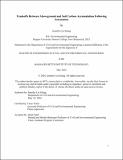Tradeoffs Between Aboveground and Soil Carbon Accumulation Following Forestation
Author(s)
Schug, Jennifer Lin
DownloadThesis PDF (753.3Kb)
Advisor
Terrer, César
Terms of use
Metadata
Show full item recordAbstract
Recent decades have seen a rapid increase in global warming due to anthropogenic greenhouse gas emissions. One prevalent climate change mitigation strategy is tree planting, as trees sequester large amounts of carbon in their aboveground biomass. However, there is emerging evidence that under some conditions, soil carbon decreases following forestation, offsetting the carbon accumulated aboveground and rendering carbon sequestration efforts ineffective. The factors driving these changes in net ecosystem carbon are currently unknown. Here, we conducted a global meta-analysis on the factors affecting aboveground biomass versus soil carbon (SOC) accumulation following forestation in grasslands and croplands. We considered the effects of prior land use, regrowth strategy, mycorrhizal associations, and environmental factors on total ecosystem carbon and SOC accumulation over time. Results indicate that while there is a tradeoff between SOC and aboveground carbon accumulation, the loss of SOC does not negate the increase in aboveground carbon following forestation. Sites with low initial SOC before forest establishment accumulate more SOC than sites with high SOC, regardless of prior land use. Overall, forest stand age, prior land use, regrowth strategy, and mycorrhizal associations drive carbon accumulation over time and should be considered in the context of future forestation projects implemented for carbon sequestration.
Date issued
2024-05Department
Massachusetts Institute of Technology. Department of Civil and Environmental EngineeringPublisher
Massachusetts Institute of Technology